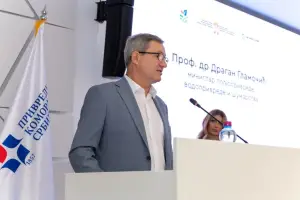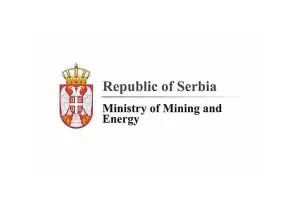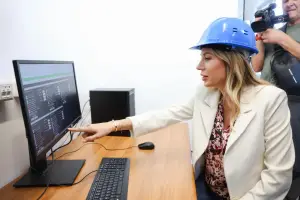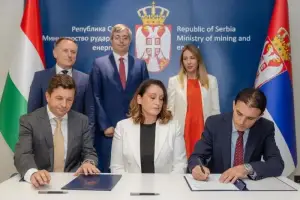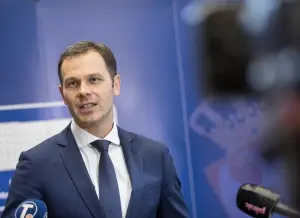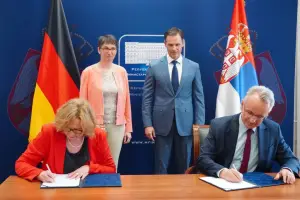Q:
A:
Government support for companies doing business in former Yugoslav republics
Belgrade,
30 November 2009
Deputy Prime Minister and Minister of Economy and Regional Development Mladjan Dinkic said today that the Serbian government will provide suitable political and financial support to companies doing business on the markets of the former Yugoslav republics.
Speaking at the forum “Economic Cooperation between Former Yugoslav Republics”, Dinkic said that last year Serbia’s trade with them stood at nearly €4.4 billion.
He said that in 2008, Serbia had a trade surplus with these countries, adding that exports stood at €2.8 billion and imports at €1.6 billion.
He said that 37% of Serbia’s exports go to the former Yugoslav republics, while imports from them make up 11% of Serbia’s total imports, adding that the volume of trade with Bosnia-Herzegovina is the largest.
Dinkic said that trade with Bosnia-Herzegovina stood at €1.35 billion last year, adding that second to that was the €1 billion trade with Montenegro, followed by Macedonia, Slovenia and Croatia.
Serbia’s highest goods export is to Bosnia-Herzegovina, while the largest surplus was in trade with Montenegro, followed by Bosnia-Herzegovina and Macedonia, said Dinkic, adding that Serbia has a deficit in trade with Slovenia and Croatia.
Besides trade another important aspect of economic cooperation between the former Yugoslav republics are investments. Serbia has received the most investment from Slovenia including Merkator, Cimos, Merkur, Droga Kolinska and Gorenje, while the top Croatian investors are Agrokor and Nexe Group.
He said that Serbia has invested €12 billion in the former Yugoslav republics and its largest investment is by Telekom Srbija in Telekom Srpska, the Serbian companies Hemofarm, Delta and Commercial Bank have also invested in Bosnia-Herzegovina, Delta and Telekom have made investments in Montenegro, while investments in Slovenia and Croatia are significantly smaller. Dinkic announced that the government will endorse Serbia’s investment in the Bar harbour from the budget since it will be a minority owner in the joint company to be formed with Serbian companies interested in taking part.
He also said that next year Serbia will take over the CEFTA presidency and its main goals will be liberalisation of the services and public procurement markets.
There is an opportunity for the joint participation of former Yugoslav countries at third markets, he also added.
The Deputy Prime Minister said that Serbia’s budget revenue increased 0.7% this year in comparison with the same period 2008, which shows that the government made showed good judgement when it decided to reduce public spending and keep taxes at the same levels.
Serbia’s budgetary deficit will this year stand at 4.3% of GDP, which is somewhat lower than projected, but next year the consolidated deficit will stand at around 4% of GDP, he explained.
Dinkic stressed that a GDP recovery trend has been recorded in Serbia, since the October industrial output for the first time exceeded last year’s average by 1.5%, although it is 5.8% lower than in the same month last year.
Dinkic recalled that around one billion Euros in subsidised loans was approved this year, of which sum only €50 million from the budget was allocated for subsidising interest rates.
World Bank representative in Serbia Marina Ves said that the worst part of the recession is over in South-eastern Europe, but noted that growth rates will be lower in the upcoming years, as well as capital flow, while investment will be reduced.
She said that slower economic growth will permanently affect the poverty rate in the region, noting that in the next several years it will be 20% higher than anticipated.
He said that in 2008, Serbia had a trade surplus with these countries, adding that exports stood at €2.8 billion and imports at €1.6 billion.
He said that 37% of Serbia’s exports go to the former Yugoslav republics, while imports from them make up 11% of Serbia’s total imports, adding that the volume of trade with Bosnia-Herzegovina is the largest.
Dinkic said that trade with Bosnia-Herzegovina stood at €1.35 billion last year, adding that second to that was the €1 billion trade with Montenegro, followed by Macedonia, Slovenia and Croatia.
Serbia’s highest goods export is to Bosnia-Herzegovina, while the largest surplus was in trade with Montenegro, followed by Bosnia-Herzegovina and Macedonia, said Dinkic, adding that Serbia has a deficit in trade with Slovenia and Croatia.
Besides trade another important aspect of economic cooperation between the former Yugoslav republics are investments. Serbia has received the most investment from Slovenia including Merkator, Cimos, Merkur, Droga Kolinska and Gorenje, while the top Croatian investors are Agrokor and Nexe Group.
He said that Serbia has invested €12 billion in the former Yugoslav republics and its largest investment is by Telekom Srbija in Telekom Srpska, the Serbian companies Hemofarm, Delta and Commercial Bank have also invested in Bosnia-Herzegovina, Delta and Telekom have made investments in Montenegro, while investments in Slovenia and Croatia are significantly smaller. Dinkic announced that the government will endorse Serbia’s investment in the Bar harbour from the budget since it will be a minority owner in the joint company to be formed with Serbian companies interested in taking part.
He also said that next year Serbia will take over the CEFTA presidency and its main goals will be liberalisation of the services and public procurement markets.
There is an opportunity for the joint participation of former Yugoslav countries at third markets, he also added.
The Deputy Prime Minister said that Serbia’s budget revenue increased 0.7% this year in comparison with the same period 2008, which shows that the government made showed good judgement when it decided to reduce public spending and keep taxes at the same levels.
Serbia’s budgetary deficit will this year stand at 4.3% of GDP, which is somewhat lower than projected, but next year the consolidated deficit will stand at around 4% of GDP, he explained.
Dinkic stressed that a GDP recovery trend has been recorded in Serbia, since the October industrial output for the first time exceeded last year’s average by 1.5%, although it is 5.8% lower than in the same month last year.
Dinkic recalled that around one billion Euros in subsidised loans was approved this year, of which sum only €50 million from the budget was allocated for subsidising interest rates.
World Bank representative in Serbia Marina Ves said that the worst part of the recession is over in South-eastern Europe, but noted that growth rates will be lower in the upcoming years, as well as capital flow, while investment will be reduced.
She said that slower economic growth will permanently affect the poverty rate in the region, noting that in the next several years it will be 20% higher than anticipated.


